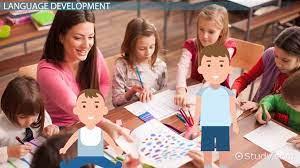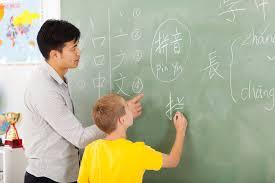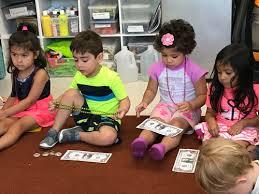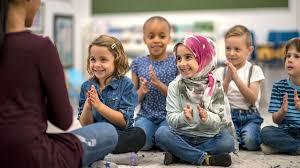Introduction
Early childhood teachers are a group of educators issuing career guides to learners undergoing various developmental transitions of learning and socializing in the external surroundings away from homes. The professionals provide a safe learning environment and engagement spaces in manners that shape the future traits, attitudes, and intelligence of learners. According to Dogan-Altun (2018), early childhood education (ECE) has often been misunderstood and underrated based on its name; however, the article challenges readers to acknowledge the role of children educators before making falsehood perceptions about ECE. Children learn how to associate with one another during their early stages of development through different frameworks. However, the newsletter about the responsibility of early childhood teachers familiarizes readers with new insights on ECE and the associations of tutors and children in such learning spaces.
Emergent-Literacy Learning
Children are exposed to the concepts of emergent-literacy learning during early childhood education. ECE teachers are crucial in influencing speech and language development through social learning approaches for individuals with special communication needs (Ebbeck et al., 2019). Besides, ECT impacts emergent-literacy learning through establishing read-aloud routines, sharing a see-show-say policy, capturing children’s interests before dividing them into play groups, and supporting children in learning more than one language (Harju-Luukkainen and Kangas, 2021). In addition, research indicates that early childhood educators help children to develop complex speech and language skills for future usage in the construction of sentences and interaction with peers (Leggett, 2017). Language learning among children develops from birth; once an infant is born, they struggle to adapt to the new environments through languages best understood by their caregivers.
The ability of a child to cry when in need of breastmilk or pain is evident that children develop communication skills from birth. However, teachers play a significant role during ECE to ensure school-aged children gain speech and language skills that are important for reading and writing. Emergent-literacy learning applies to children’s daily lives upon interactions with print media and association with peers in everyday situations at elementary levels. Early childhood teachers (ECT) not only train children to write, read, or draw things happening in their daily problems but also educate learners on how to appreciate and recognize rhyming and scribbling words (McLachlan, 2021). Emergent-literacy learning skills are essential to children attending early childhood education since the knowledge facilitates the combination of what pupils know and what they learn about listening and speaking.
Children’s Language Learning
Moreover, early childhood teachers impact children’s language learning by implementing various strategies. A teacher employed in any ECE facility plays the primary role of establishing activities and conditions suitable for the development of language learning and practice (Popescu and Noiray, 2021). ECT would use word games, homonyms, tongue twisters, storytelling, and songs to support families and children using English as a second language to enrich the language, emergent literacy, and multiliteracy learning (Shepard-Carey, 2019). ECT uses tongue twisters in excellent and fun ways to teach children the correct pronunciations of hand word enunciations. ECE institutions employ trained teachers to facilitate children’s language learning because the group of professionals can predict the needs of children in communicative language activities based on multiple interactions. Introduction of vocabulary to learners during read-aloud classes can boost the enrichment of emergent literacy for non-native language speakers.

The demanded high degrees of success in language development in early childhood education work with hiring adequately trained teachers. According to Sheppard and Moran (2021), teachers incorporate puzzles in language development classes to paint pictures of situations in children’s everyday lives. The outcomes of such strategies help learners to read or cite such riddles. Language development incorporates practical and theoretical training, which requires professionals, and early childhood teachers to assist learners in developing humor in their narrations and writing through communication models.
Construction of the Environment
Furthermore, early childhood educators help school-aged learners construct the childhood environment. ECT would use humorous strategies in social settings to support children and families with English as a second language to enrich language and emergent learning. For example, the dynamic roles of early childhood teachers to incorporate riddles, tongue twisters, storytelling, rhymes, and songs in children’s language classes can boost multiliteracy learning. Teachers dealing with learners should be praised for the provision of safe environments for learning; without the experts, children’s mix-ups could persist in learning spaces making it difficult to isolate daycare and pre-primary classes (Sohn and Youngmi, 2018). Childhood environments communicate the intentions of learning; thus, early childhood educators are integral to the success of childhood education. Separating children into various classes enables ECE to concentrate on particular teaching models depending on age brackets (Whitters, 2020). Early childhood trainers shape the environments in which children learn, play, and interact with each other; the outcomes of such plans increase the security of learners. Childhood environments support the learning of infants, preschoolers, and toddlers; therefore, childhood educators are responsible for developing children’s challenging behaviors through the constructed environments. In Leggett’s (2017) opinion, the learning environments created by early childhood educators serve as the primary components of interventions for individuals with disabilities. Special needs children cannot be put in the same playgroups with other pupils because the group needs additional care.

The role of the teacher in constructing environments in early childhood arises with the gaps in the needs and differences of childcare. The state needs to honor early childhood educators for the excellent job of helping parents identify children with disabilities through the social construction approaches in developing learning environments. A review conducted by the Division for Early Childhood Recommended Practice (DEC-RP) suggested that teachers engage in the design of the space, equipment, materials, and routine activities to support learning (Sohn and Youngmi, 2018). DEC-RPs research findings also stressed the importance of childhood environment construction; in the analysis, children learning across developmental domains are supported by excellent environmental practices. Without early childhood educators, institutions and pupils would lack the knowledge and ability to construct valuable environments. Well-deigned classrooms for early childhood development must be characterized by promoting children’s engagement and supportive and responsive caregiving. The communication, motor, cognitive, and social developmental domains must also facilitate appropriate interactions and encourage staff efficiency to be classified as a productive environment.

Multiliteracies Learning
Multiliteracies learning is essential in early childhood education because the knowledge defines language use. Exposing children to technical training or usage at an early age prepares such individuals for better interactions with technology. Multiliteracies learning helps children acquire unique skills in the variability of languages in numerous cultures; thus, teachers incorporate the learning model in childhood education to facilitate the diversity of cultures (Shepard-Carey, 2019). Adaptability in early learning spaces starts from accepting and respecting people’s cultures across multiple diversities. The elimination of discriminative approaches to particular languages occurs without proper upbringing and training of individuals in early childhood development. However, the presence of early childhood educators simplifies multiliteracies learning through the improvement of several social and cultural domains. The differences in communications at later stages of development are reduced by the engagement of specific contexts created by early childhood educators. Significant changes in the communication frameworks of children start from implementing multiliteracies learning in ECE.
Multiliteracies learning promotes the know-how of literacy teaching; as a result, early childhood learners benefit from the policies and standard rules of national language usage. ECE teachers help learners gain multiliteracies knowledge through children’s exposure to the consequences of the social domain, life experiences, culture, and gender. The differences in subject domains listed in multiliteracies learning play a role in shaping and molding individuals perceptions and values about language use and practice.

Conclusion
The relationship between early childhood educators and toddlers impacts the future success of pre-primary learners in various stages. Teachers create safe and productive environments by influencing children’s learning patterns and behavior. Multiliteracies learning provides adequate foundations for children to prepare for multiple language learning. According to the newsletter’s findings, speech and writing skills originate from the training of ECT to properly handle people transitioning through childhood developmental stages.
References List
Dogan-Altun, Z., (2018) Early Childhood Pre-Service Teachers’ Perspectives on Play and Teachers’ Role. International Education Studies, 11 (8), pp. 91-97.
Ebbeck, M., Yim, H.Y.B., and Wei, T., (2019) Preparing children for an uncertain future: the role of the early childhood teacher. Journal of Early Childhood Teacher Education, 41 (3), pp. 223–240.
Harju-Luukkainen, H., and Kangas, J., (2021) The Role of Early Childhood Teachers in Finnish Policy Documents—Training Teachers for the Future? International Perspectives on Early Childhood Teacher Education in the 21st Century. Springer Nature, pp. 65–80.
Leggett, N., (2017) Early Childhood Creativity: Challenging Educators in Their Role to Intentionally Develop Creative Thinking in Children. Early Childhood Education Journal, 45 (6), 845–853.
McLachlan, C., (2021) Multiliteracies in Early Childhood Education, in Education. Oxford University Press.
Popescu, A., and Noiray, A., (2021) Learning to Read Interacts with Children’s Spoken Language Fluency. Language Learning and Development, 18 (2), pp. 151–170.
Shepard-Carey, L., (2019) The inference-making of elementary emergent multilingual: Access and opportunities for learning. Journal of Early Childhood Literacy, 21 (4), pp. 499–537.
Sheppard, M.E., and Moran, K.K., (2021) The Role of Early Care Providers in Early Intervention and Early Childhood Special Education Systems. Early Childhood Education Journal 50 (3), pp. 891–901.
Sohn, S.Y., and Youngmi, L., (2018) Early Childhood Teachers’ Perception and Needs for the Operation of Role Play Area. Early Childhood Education and Care, 13, pp. 221–244.
Whitters, H.G., (2020). Adverse childhood experiences, attachment, and the early years learning environment, in Adverse Childhood Experiences, Attachment, and the Early Years Learning Environment. Routledge, pp. 72–82.